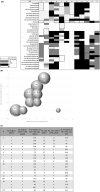TSPO-PET in pre-surgical evaluations: Correlation of neuroinflammation and SEEG epileptogenicity mapping in drug-resistant focal epilepsy
- PMID: 39679816
- PMCID: PMC11827756
- DOI: 10.1111/epi.18182
TSPO-PET in pre-surgical evaluations: Correlation of neuroinflammation and SEEG epileptogenicity mapping in drug-resistant focal epilepsy
Abstract
Objectives: Resective surgery in drug-resistant focal epilepsy (DRFE) requires extensive evaluation to localize the epileptogenic zone (EZ). When non-invasive phase 1 assessments (electroencephalography, EEG; magnetic resonance imaging, MRI; and 18F-Fluorodeoxyglucose-positron emission tomography, [18F]FDG-PET) are inconclusive for EZ localization, invasive investigations such as stereo-EEG (SEEG) are necessary. Epileptogenicity maps (Ems) visualize the EZ using SEEG-identified ictal high-frequency oscillations (iHFOs). PET imaging with radioligands targeting the18-kDa translocator protein (TSPO), a marker of glial activation, may aid EZ localization. This study investigates the correlation between TSPO-PET imaging and SEEG iHFOs in DRFE to determine the utility of TSPO-PET in pre-surgical assessments, especially in complex or non-lesional cases.
Methods: Patients with DRFE and inconclusive phase 1 assessments were recruited from Bicêtre Hospital (AP-HP) for a prospective study (Eudract 2017-003381-27). They underwent SEEG and [18F]DPA-714 (N,N-diethyl-2-(2-(4-(2-(fluoro-18F)ethoxy)phenyl)-5,7-dimethylpyrazolo[1,5-a]pyrimidin-3-yl)acetamide) (TSPO radioligand) PET imaging. Statistical parametric mapping (SPM) techniques analyzed significant [18F]DPA-714-PET uptake (TSPO-map) and generated epileptogenicity maps (EM-map). Correlation analyses at regional and voxel-of-interest (VOI) levels assessed the relationship between TSPO-map and EM-map.
Results: We were able to obtain and analyze both maps in 12 of 17 patients recruited. A significant positive correlation between EM-map and TSPO-map in focal epilepsies was found regionally (r = .81, p < .00004) and at the VOI level (r = .79, p < .00003). Temporal, insular, parietal, and occipital regions showed particularly strong correspondence. In frontal epilepsies, TSPO-map was more focal than EM-map, suggesting increased specificity for SEEG planning. This study also demonstrated the benefit of the TSPO-map in identifying multiple foci in multifocal epilepsies, with or without lesions.
Significance: These findings suggest that neuroinflammation may be a molecular substrate of the EZ in non-lesional focal epilepsy. Identifying the EZ inpatients with complex DRFE and inconclusive MRI/[18F]FDG-PET imaging is essential to improve resective surgery outcomes. Combining TSPO-PET imaging with SEEG recordings may help bridge this gap.
Keywords: TSPO‐PET; drug‐resistant epilepsy; epilepsy surgery; epileptogenicity maps; neuroinflammation; statistical parametric mapping.
© 2024 The Author(s). Epilepsia published by Wiley Periodicals LLC on behalf of International League Against Epilepsy.
Conflict of interest statement
None of the authors have any conflicts of interest to disclose.
Figures


References
-
- Cosenza‐Nashat M, Zhao M‐L, Suh H‐S, et al. Expression of the translocator protein of 18 kDa by microglia, macrophages and astrocytes based on immunohistochemical localization in abnormal human brain. Neuropathology Appl Neurobio. 2009;35:306–328. 10.1111/j.1365-2990.2008.01006.x - DOI - PMC - PubMed
-
- Sauvageau A, Desjardins P, Lozeva V, Rose C, Hazell AS, Bouthillier A, et al. Increased expression of “peripheral‐type” benzodiazepine receptors in human temporal lobe epilepsy: implications for PET imaging of hippocampal sclerosis. Metab Brain Dis. 2002;17:3–11. 10.1023/A:1014044128845 - DOI - PubMed
MeSH terms
Substances
Grants and funding
LinkOut - more resources
Full Text Sources
Research Materials
Miscellaneous

